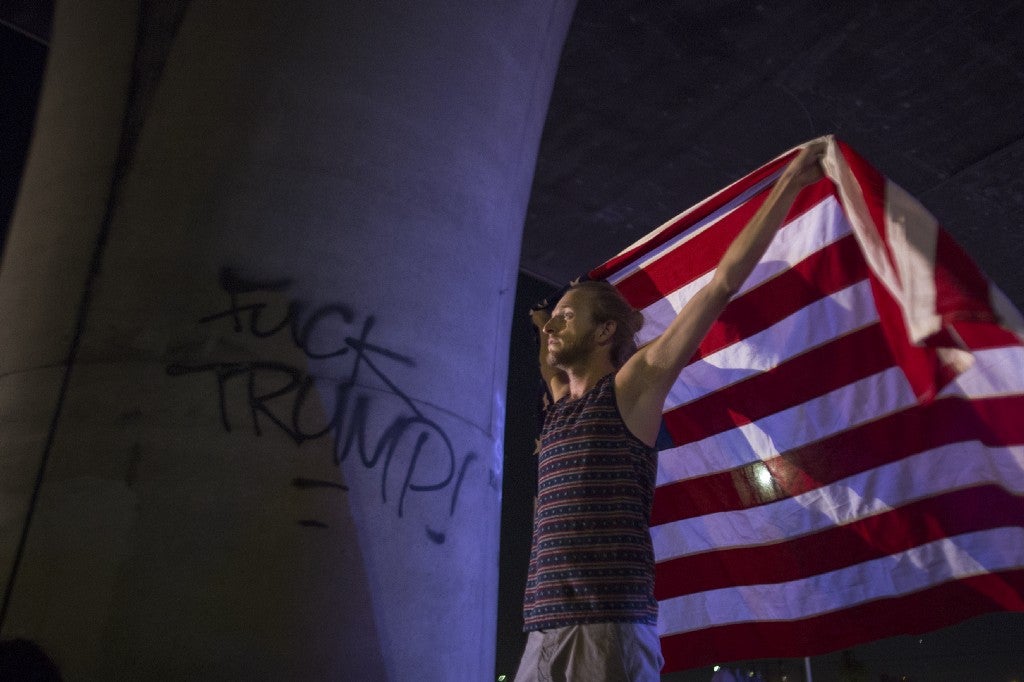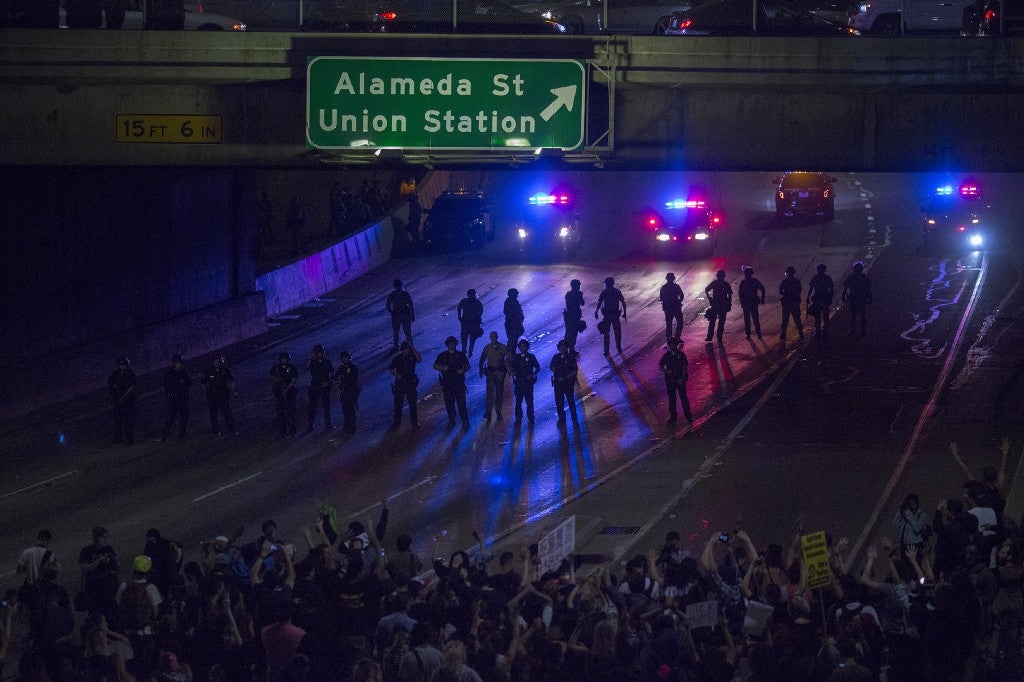Only in L.A. can you wear a tank top to a protest in November. I saw plenty of them — emblazoned with phrases like “Pussy Grabs Back,” “Fear Is The Greatest Incapacitator,” and “Fuck Your Wall” — when I went to downtown Los Angeles on Wednesday night.
I had spent the last 16 hours watching cable news and numbing out to the point that I fell asleep and my dream was narrated by Wolf Blitzer. As the day stretched on, videos of crowds marching in New York, Chicago and D.C. began rolling on-screen: The anti-Trump protests had begun.
Just like the voting polls, L.A. was one of the last cities to “report” for protesting because, well, Pacific Standard Time. But by 7:00 p.m., there were already around 300 people in formation, burning a Trump effigy in front of City Hall.
I didn’t arrive on the scene until a little later because I was waiting on a friend who, fittingly, was attending a lecture on dystopian societies at the University of Southern California. When we got to the protest, the crowd had swollen to well over 1000. People were moving down the streets from City Hall to Pershing Square with placards, flags, bullhorns and drums. Cars that got stuck rolled down their windows and beeped their horns to the rhythm of the crowd’s chants.

“Love Women Don’t Grab Them,” “My Body, My Choice,” “F — — Pence!” echoed as hundreds of people marched. One couple carried a sign that simply said “OCTAVIA BUTLER” — an African-American science fiction writer whose work explored themes of racism and bullying.
An 18-year-old named Isaac sporting one of the “Pussy Grabs Back” tanks said he had voted for the first time on Tuesday, going straight after school to cast his ballot for Clinton (after never having received his vote-by-mail ballot). He was disappointed, telling me “it sucked because I went to the extra effort and the extra effort didn’t work.”
“I’m of the Hispanic race,” he added, “and from the beginning, all the immigration comments [made by Trump] — saying that all Hispanics and immigrants are rapists and criminals and his comments about women… [The election outcome] just shows that misogyny and racism are alive in America, which is sad.”
For all the intense emotion and rhetoric, there seemed to be feeling of radical acceptance about Trump’s victory: it had happened, it was a reality, they were not pleased and they’d continue to voice their dissent. The physical vibe was energetic but not chaotic; people were marching calmly and orderly.
The collective action itself — coming together to voice dissent — seemed to buoy many.
“Posting on Facebook isn’t enough,” a girl named Alexis told me. “It’s good to just get out. Even though I know this isn’t gonna change much, it’s nice to show that we are not supporting him [Trump].”
Another point of unity? For most, the past 24 hours had been brutal — true mourning in America.
“I’ve had a horrible day since yesterday,” one 20-something musician who declined to give his name said, proclaiming that Trump’s win was a blow to his family (he wouldn’t specify exactly why).
An LGBTQ lawyer named Emily told me she had been watching the election results at The Abbey in West Hollywood and left early. “I didn’t want to be around people anymore,” she said. “I’m like a zombie. I didn’t want to talk to anyone I worked with. I hid in my office all day.”

She added, “My grandparents were Holocaust survivors and it’s never been lost on me that it could happen again. It’s important to all be out here together, staying strong, because I do think that a dictator — an authoritarian leader — is a real possibility.”
The marchers ended up back in front of City Hall, where I watched a guy in a Joy Division shirt and black facemask shimmy up a stoplight to throw a Trump-head piñata out to the crowd. Firecrackers began going off and I almost got hit in the head by a Donald effigy that was getting kicked around.
Things were getting a little intense, so we called an Uber to head home. The protest was beginning to seem like it lacked an objective other than vocalizing anger and frustration. It made me wonder what people would do with the rage, frustration and anger other than burn effigies. The problems have been identified; what are the solutions now? What happens next?
Calexit?!
“I actually posted about [Calexit] today,” Alexis — the girl I had spoken with earlier — said. “I think our country’s too big and it’s too polarized and we obviously aren’t ever gonna fully agree. So why not Calexit? Let’s just be with like-minded people.” Pause. “And let’s have Bernie involved some way.”
As it goes, we ducked out too early for the real action. As our car pulled onto the 101 Freeway, a thick swarm of demonstrators were walking onto it. By 11:00pm, it was shut down while traffic backed up for miles and police in riot gear arrested around 28 people, according to KTLA.
Angeleno drivers are used to standstills on the roads and they figure out a way to keep moving along. It’ll be interesting to see how the anti-Trump movement can do the same — keep going — and determine what the best course of action is to get to to the next road. Stay tuned.
